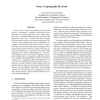Free Online Productivity Tools
i2Speak
i2Symbol
i2OCR
iTex2Img
iWeb2Print
iWeb2Shot
i2Type
iPdf2Split
iPdf2Merge
i2Bopomofo
i2Arabic
i2Style
i2Image
i2PDF
iLatex2Rtf
Sci2ools
108
Voted
NDSS
2003
IEEE
2003
IEEE
Proxy Cryptography Revisited
In this work we revisit and formally study the notion of proxy cryptography. Intuitively, various proxy functions allow two cooperating parties F (the “FBI”) and P (the “proxy”) to duplicate the functionality available to the third party U (the “user”), without being able to perform this functionality on their own (without cooperation). The concept is closely related to the notion of threshold cryptography, except we deal with only two parties P and F, and place very strict restrictions on the way the operations are performed (which is done for the sake of efficiency, usability and scalability). For example, for decryption (resp. signature) P (F) sends a single message to F (P), after which the latter can decrypt (sign) the message. Our formal modeling of proxy cryptography significantly generalizes, simplifies and simultaneously clarifies the model of “atomic proxy” suggested by Blaze and Strauss [4]. In particular, we define bidirectional and unidirectional vari...
Computer Networks | NDSS 2003 | Proxy Cryptography | Threshold Cryptography | Various Proxy Functions |
Related Content
| Added | 05 Jul 2010 |
| Updated | 05 Jul 2010 |
| Type | Conference |
| Year | 2003 |
| Where | NDSS |
| Authors | Anca-Andreea Ivan, Yevgeniy Dodis |
Comments (0)

